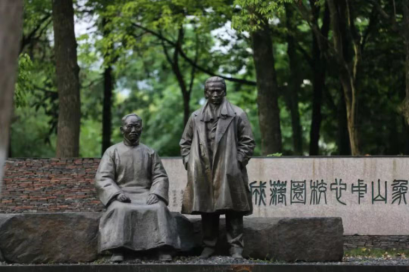Marching Towards Comprehension
Author:Xu Jiang Release time:2023-11-27Four years has passed since the opening of the comprehensive painting pilot class. As the old saying goes, “it takes a decade to grow trees, but a century to cultivate men”; a new educational attempt, to be valued as successful, shall undergo a complete cycle of academic schedule. As this academic session is running towards its end, the comprehensive painting studio would like to arrange a booklet which includes documentaries, illustrations and essays to review the exploration of the last few years. Sort out the reasonable relationship of the internal structure as an independent discipline, and clarify the development direction of comprehensive painting. This spirit of hard work, cooperation and pragmatism is very valuable. We hereby wish to sort out the rational relationship of the internal structure as an independent discipline, and clarify the development direction for comprehensive painting. This spirit of effortful cooperation and pragmatic innovation is indeed valuable.


Part I
“Comprehensive Painting”, as an adacemic module, has been an experimental teaching program among the other courses taught in China Academy of Art, whose majors are mainly defined by the genres of art. However, its basic guiding ideology to integrate Chinese and Western cultures, has always emenated deep and magnificent echoes in the development of Chinese art education in this century – especially in the development of our academy. As early as 1926, the then principal of the Beijing Academy of Art Mr. Lin Fengmian, has published a series of articles, namely The Future of Eastern and Western Art, describing his ideaology of art education.
Based on academic cotentions such as the origin of art as well as the similarities and differences between Eastern and Western art, Mr. Lin put forward a relatively global conception of reconciling and coalesing the Chinese and the Western. “Western art, as an immitation-oriented genre, prefers a realistic result. Oriental art, whose emphasis is on depicting the imaginaion, looks forward to a freehand but depictive result….the former seeks external manifestations wihle the later prefers those that are internal. Proter the different methodologies, the ostensible form shall be different; the differences yieled their prospective strengths and weaknesses, therefore demonstrating the neccessity of communication and reconciling the East and the West!”In 1928, appointed by Mr. Cai Yuanpei, he and a group of like-minded educators founded the National Academy of Art with the academic slogan of “Introduce Western art, organize Chinese art, reconcile the Chinese and Western art, and create epochal art”. On the second year after the establishment of the academy, the Department of Chinese Painting and the Department of Western Painting were merged into the Department of Painting, aiming to train “artists who can master ancient and modern, Chinese and foreign art theories and excel in creativity at the same time”. Professor Lin Fengmian's thought of fusion influenced the first decade of our school's establishment, and cultivated a generation of students. His radical educational image of "cultivating new artists and leading new art movements as his bounden duty" has been engraved in the history of modern Chinese art development. Despite the drastic changes in the world, the idea of integration still condenses into a profound spiritual realm, giving birth to the consistent academic characteristics of our school that emphasizes integration in various historical periods.
The proposal and creation of the comprehensive painting studio is a concentrated reflection of the academic integration characteristics of our school, and it is also a current manifestation of the innovative needs stored in our school's academic spirit. Undoubtedly, the comprehensive painting studio has inherited the ideological connotation of "harmonizing Chinese and Western art" from its predecessors, and at the same time introduced the academic ideals and spiritual context of the generation at the turn of the century. After the Second World War – especially after experiencing the baptism of the modern art frenzy in the 1950s and 1960s, the trend of dividing majors by painting types in Western art academies has been gradually replaced by bold expression in media and free expression of ideas. The pan-media title “Mixed Media” started to prevail in a large number of exhibitions, showing even stronger realistic vitality than traditional paintings. Witnessing those phenomena, Chinese artists in the reform and opening up era started to introspect from various aspects. It is against such a background that the experimental creation of comprehensive painting has gradually become one of the hottest categories among the current genres of modern China's artistic creations. The comprehensive painting pilot class of our school is the earliest attempt to carry out systematic comprehensive painting teaching in art colleges and universities across the country. It is, on one hand, a bold and experimental process, and on the other hand an inevitable step in the torrent of modern and contemporary art education reformation.
Part II
The key to comprehensive painting teaching is "comprehensiveness". From this point of view, comprehensive painting refers to the comprehensive use of materials across painting types, eventually achieving comprehensive expression – such definition shall be inerrable. On one hand, comprehensivenss focuses on drawing from characteristics of various painting types and professional disciplines as well as to master the spirit and skills of both Chinese and Western paintings, striving for excellence. On the other hand, comprehensiveness also refers to the purport of separating from the habitual concepts of painting genres and internalizing them as its own characteristics. Therefore, the essence of synthesis is to understand and integrate, and to obtain new ones through sublimation of thoughts.
Such comprehansion will inevitably includes three levels of "breakthrough": the breakthrough of material, form and concept. The comprehensive cross-genre use of materials is by no means a simple combination of “A+B”, but shall be a process of choice and fit of various material features in the sense of creative personality. Nevertheless, the above-mentioned breakthrough shall not be limited to the mere experimental "grafting" of ready-made Chinese painting media such as painting with oil-based paint on xuan paper, or spreading paint in the way of Chinese painting on oil canvas. Neither should it be a visual “adventure” of various media forms, jumping in between nterlaced edges. It should be an experimental project that absorbs the overall cultural spirit, who is not confined to the existing material forms. In due course, it shall eventually become a “source-seeking project” that takes the subject back to the nature of human originality. It is on the basis of this understanding that comprehensive painting seeks freedom with experimentation, cuts into the unknown from the peripheral, and leads from comprehensiveness to originality.
In this sense, comprehensive painting is not an integrated type of painting with a certain characteristic, nor is it another new type of painting besides Chinese, oil and printmaking. The comprehensive realm is a realm that transcends specific genres of painting, a domain that continuously creates various new possibilities on the basis of integration, providing the greatest space for joy and movement for a strong and vigorous creative personality. Therefore, the teaching of comprehensive painting is, first of all, an open educational project oriented towards the creative qualities of people.
Part III
As an open educational project, comprehensive painting teaching has an inherent experimental nature. What it adopts is a teaching framework transforming from a chain structure to a linear structure – that is, starting from the observation and learning of natural and traditional morphological changes, it is essentially a training structure forming a chain of training courses through the decomposition and strengthening of various genes of visual phenomena to help students build their basic abilities. In addition, through linear stages of deepening, the individual qualities of the trainees are synthesized into a comprehensive personality language.
This framework is a process to properly decompose the process of artistic creation, which is a multi-layer structure comprehensive activity that is also presented and interpenetrated, into a multi-level and horizontal pattern, providing a veritable foundation for the formation and development of creative personality. In such an open training, the phenomenon that one should take warning from is that in various trainings, the personal experience of the trainee is ignored, while the "fait accompli" created by the master is emphasized and used in a certain narrow-mided form. The rich and colorful visual presentation of the trainees are banished, and the subject of creativity are intentionally or unintentionally driven out of the basic modules. Here, we shall think from the perspective of the existence of the educated. The consciousness of the educated, the function of self, the subject of observation and perception would commence and exist at the same time while being related and echoing. Rooted in the spirit of coalecing and coordinating soul with nature, such objective of painting is the most crucial core of this open training, as well as the fundamental rationale for teaching creative qualities without wandering into the realm of false reasoning.
For those being educated, each new course is a brand-new area. The trainee's vision collides and shines in this constitutive discipline, whose recessivity-dominance duality gradually opens up a new strange and vivid realm during this occurrence. This requires students not to be bound by fixed opinions, to face the unknown, to be open-minded, to fully open up his or her inner potential, and to endow one’s vision with meaning via the movement of the recessivity-dominance duality. Such courses and visual movements are materialization processes of the originarius, a process of mutual understading between formative rules and spontaneous, instant decisions; it shall also be a painstaking trial and error for the learners on their path seeking for the truth.
In this open training, the curriculum about materials is critical yet arduous. Here, the relationship between the individual, the appratuses and the materials must be considered from the perspective of the learner. Whether the tools and media chosen are conventional in a certain painting genre, or that they are novel materials seen in daily life, they will all have their corresponding scope and context of application. Such scope and context of application provides the cause and rationality for tools and materials to be invented. The extensive use of xuan paper, the integrity and long history of “The Four Treasures of the Study”, the aesthetics of the traditional painting and cultural clou etc. hypostatised the rationale of using xuan paper in contemporary days. The chain of reasoning that links tile plaster, texture, touch and the serendipity of one’s possibility of existence constitutes the whole of causes and rationale of using materials such as tile plaster. It is in the continuous contact with such systems of cause and rationality that the individual realizes the serendipity and possibility of using certain tools and materials. It is exactly in the process of merging and connecting with the appratuses and media that one can develop a unique state of familiarity, thus advancing and internalizing such experience into a unique visual language.
Therefore, the essence of such an open teaching framework is to scaffold a way of experiencing the virtual presentation of human existence. A pivotal bottleneck in this specific way of experience will be the transformation from basic chaining structure to a linear in-depth structure of creativity phase. How to prevent the trainees from suffering setbacks on the chaining phase, whilst gradually stablize, assist and impel their progress on top of the natural presentation of their personal qualities, is key to comtemporary art education. often makes the reform of art education fall into a trap. The key point of emptiness is also what we are bound to and cannot avoid in our hard work today. That exact proposition is often the climacteric reason that makes the reform of art education vague, while also being the inevitable and unavoidable challenge on our path of efforts today.
As I am in this moment writing the article, came the news that our sister school announced their plan of offering comprehensive painting courses. I sincerely hope this booklet can serve as a handy reference for China's comprehensive painting teaching – or, even art education in general. If it could, by any means, induce some positive thinking, it would be a great thing to see. After all, the territory of vision in China is vast and prosperous. Each and every one of us is living together with the tide of time, in such an exciting world of cause and rationale.
Xu Jiang
May, 1999
This article was originally published in The Road of China Academy of Art: Indermedia Art Volume, Hangzhou: China Academy of Art Press, 2018, pp. 31-33.
Translated by Zhao Jun from Chinese into English




